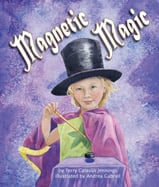Alignment to CORE and NGSS Standards

| Grade | Number | Standard |
|---|---|---|
| 1 | RI.1.9 | Identify basic similarities in and differences between two texts on the same topic. (story versus For Creative Minds non-fiction component) |
| 1 | RL.1.5 | Explain major differences between books that tell stories and books that give information, (paired fiction & For Creative Minds non-fiction) |
| 2 | NGSS: 2-ESS2.B | Maps show where things are located. One can map the shapes and kinds of land and water in any area. (2-ESS2-2) |
| 2 | RI.2.4 | Determine the meaning of words and phrases in a text relevant to a grade 2 topic or subject area: Earth processes: quickly/slowly, wind/water shape land, plate tectonics, maps, water: ocean/rivers/lakes-solid or liquid, STEM: drawings, plant basic needs, seed dispersal, biodiversity, state of matter: solid/liquid, small objects make larger, heating/cooling substance causes observable change, add/subtract 100-20 mentally, equal groups for multiplication foundation, odd/even numbers, place value 3 digits, skip counting, measure length using 2 different measurements (inches/feet/yard/cm/m), compare objects by measurement, number line, time to 5 minutes, money/currency, line plot, picture graph, bar graph 4 categories, shapes/angles/number faces, divide shapes into halves, thirds, quarters, fables/folktales from diverse cultures, rhyme and rhythm, compare two/more versions same story, collective nouns |
| 2 | RI.2.9 | Compare and contrast the most important points presented by two texts on the same topic. (story versus For Creative Minds non-fiction component) |
| 2 | RL.2.10-Lexile Level | By the end of the year, read and comprehend literature, including stories and poetry, in the grades 2_3 text complexity band proficiently, with scaffolding as needed at the high end of the range. Lexile Level 420L - 820L |
| 2 | RL.2.3 | Describe how characters in a story respond to major events and challenges. |
| 3 | L.3.6 | Acquire and use accurately grade-appropriate domain-specific words and phrases: Weather prediction, weather versus climate, natural hazards, life cycles, changing environments: organisms survive/move/adapt/die, animal group behavior, inherited traits, instinct/learned behavior, extinct animals, fossils, individual advantages survival/mating, habitat survival: physical/behavioral adaptations, living things change habitats, force/motion: strength/direction/electric/magnetic, multiplication/division, unknown number m/d equation, m/d fact families, two-step word problems, place value rounding, fractions, time to minute, liquid volumes, scaled picture graph/bar graph, measurements to fractional inches, line plot, area, square units, area=multiplication/division, perimeter, shapes in different categories (rhombus/rectangle=quadrilateral), divide shapes by equal area, fables/folktales/myths from diverse cultures, compare/contrast stories from same author/series, |
| 3 | NGSS: 3-PS2.B-2 | Electric, and magnetic forces between a pair of objects do not require that the objects be in contact. The sizes of the forces in each situation depend on the properties of the objects and their distances apart and, for forces between two magnets, on their orientation relative to each other. (3-PS2-3),(3-PS2-4) |
| 3 | RI.3.10-Lexile Level | By the end of the year, read and comprehend informational texts, including history/social studies, science, and technical texts, at the high end of the grades 2_3 text complexity band independently and proficiently. Lexile Level 420L - 820L |
| 3 | RI.3.3 | Describe the relationship between a series of historical events, scientific ideas or concepts, or steps in technical procedures in a text, using language that pertains to time, sequence, and cause/effect. |
| 3 | RI.3.4 | Determine the meaning of general academic and domain-specific words and phrases in a text relevant to a grade 3 topic or subject area: Weather prediction, weather versus climate, natural hazards, life cycles, changing environments: organisms survive/move/adapt/die, animal group behavior, inherited traits, instinct/learned behavior, extinct animals, fossils, individual advantages survival/mating, habitat survival: physical/behavioral adaptations, living things change habitats, force/motion: strength/direction/electric/magnetic, multiplication/division, unknown number m/d equation, m/d fact families, two-step word problems, place value rounding, fractions, time to minute, liquid volumes, scaled picture graph/bar graph, measurements to fractional inches, line plot, area, square units, area=multiplication/division, perimeter, shapes in different categories (rhombus/rectangle=quadrilateral), divide shapes by equal area, fables/folktales/myths from diverse cultures, compare/contrast stories from same author/series, |
| 3 | RI.3.9 | Compare and contrast the most important points and key details presented in two texts on the same topic. (story versus For Creative Minds non-fiction component) |
| 3 | RL.3.10-Lexile Level | By the end of the year, read and comprehend literature, including stories, dramas, and poetry, at the high end of the grades 2_3 text complexity band independently and proficiently. Lexile Level 420L - 820L |
| 5 | RI.5.5 | Compare and contrast the overall structure (e.g., chronology, comparison, cause/effect, problem/solution) of events, ideas, concepts, or information in two or more texts. (Paired reading-story versus For Creative Minds non-fiction component) |
| K | RI.K.9 | With prompting and support, identify basic similarities in and differences between two texts on the same topic. (comparing story to For Creative Minds non-fiction component) |
| K-4 | K-4)3.1.1 | Properties and functions of geographic representationsãsuch as maps, globes, graphs, diagrams, aerial and other photographs, remotely sensed images, and geographic visualization |
| K-5 | Dewey | [E] |
| K-5 | Dewey - Fiction | Fiction |